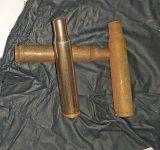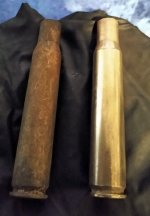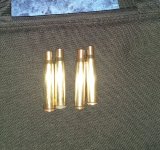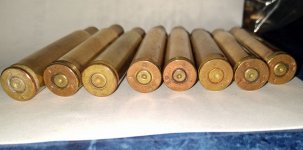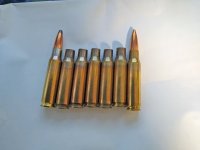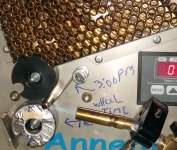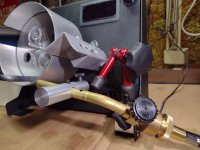For Everyone's Knowledge the Metallurgical field isn't MY specialty or vocational field , however Chemistry is so a fundamental working knowledge I do have and have had for nearly 50 years . Being in the Aerospace industry for a number of decades as an R&D PhD. Chemist specializing in Organic polymer's ,has allowed Me some pretty specialized acquaintances as well as many Friends . Those persons specialize in various design , materials and verified documented tests of said .
So this Isn't Me telling anybody anything ,one can Read for themselves and draw your own conclusions .
IF you wish to know something about the Man himself ,click this link : I believe you will find his credentials impeccable .
https://vacaero.com/information-res...er-voort/biography-george-f-vander-voort.html From the experiments of Metallurgical expert ; George Vander Voorst . Simply click the link and anyone can see visually exactly what is happening . Also Note his pioneering experiments have been verified by Numerous PhD. Students around the world .
https://vacaero.com/information-res...rmation-and-annealing-of-cartridge-brass.html Abstract Copper and its alloys are among the most malleable metals and alloys in existence. Cartridge brass, Cu – 30% Zn, has been used for many years to produce cartridge cases for ammunition due to its superior cold forming characteristics. This article shows the microstructure and hardness of cartridge brass from the fully annealed to the heavily cold worked condition. Then, it illustrates the influence of annealing temperature and time on removing the effect of the cold work and returning the alloy to a very low hardness annealed structure.
Introduction
Cartridge brass, Cu – 30% Zn, is a single-phase Cu-based alloy where the addition of zinc increases the strength of copper by solid solution strengthening. The maximum solubility of zinc in copper at ambient temperature is slightly above 30% Zn. Higher levels of Zn, for example, 40% Zn, produce two phased α-β brass which is less malleable than the single phase, α-Cu cartridge brass. Cartridge brass, as the name states, has been used for many years to make cartridges for bullets due to its excellent formability and good cold formed mechanical properties. As an example, Figure 1 shows the microstructure of the starting cup with an annealed α-Cu grain structure, exhibiting annealing twins, used to cold form cartridge cases.
Figure 2 shows the firing pin end of a formed 338 caliber cartridge case revealing a heavily cold worked microstructure. Color etching is far more effective than black & white etching to reveal the complete grain structure and deformation. Comparisons of color vs. B&W etching will be presented later.
Experiment Specimens of hot extruded and fully annealed cartridge brass were cold reduced 15, 30, 40, 50, 60 and 70% in thickness. Specimens were mounted and polished and etched using the commonly used B&W etchant of equal parts of ammonium hydroxide and hydrogen peroxide (3% conc.) mixed fresh and used by swabbing. Figures 3 a and b, 3 e and f, and 3 i and j show B&W images of longitudinal planes from the annealed (Fig. 3 a) and the cold worked cartridge brass specimens (30, 40, 50, 60 and 70% cold reductions). Figures 3 c and d, 3 g and h, and 3 k and l show color images using Klemm’s III tint etch and polarized light for the cold worked specimens (15, 30, 40, 50, 60 and 70% cold reductions). These images reveal that the grains are becoming elongated with cold reduction, with increasing length/width ratio with increasing cold reduction, plus greater amounts of slip deformation. Figure 4 shows the increase in Vickers hardness (100 gf load) from 57.9 ± 4.8 HV in the starting fully annealed condition to 231.9 ± 7.9 HV after a 70% cold reduction in thickness, a fourfold increase in hardness.
Annealing experiments were conducted on a number of the cold worked specimens. Figures 5a and b show color etched images of the specimens cold reduced 50% and then annealed 30 minutes at 500 and 700°F. No difference in the microstructure is seen in the specimen held 30 minutes at 500°F while a very small amount of recrystallization is observed in the specimen held 30 minutes at 700°F. Figures 6a and b show color images of 50% cold reduced specimens held for 4 and 8 minutes at 800°F while Figures 6c and d show 50% cold reduced specimens held 15 and 30 minutes at 800°F. No change is observed after 4 minutes at 800°F,
while a minor amount of recrystallization has occurred after 8 minutes.
Holding specimens for 15 and 30 minutes at 800°F revealed partial recrystallization after 15 minutes and full recrystallization after 30 minutes. The grain structure is relatively fine but is not uniform in its distribution.
Figures 7a and b illustrate the grain structure in color after 15 and 30 minutes at 900°F. The 15 minute hold produced a non-uniform grain structure while the 60 minute hold produced better results although the grain size distribution appears to be duplex. Figures 8a and b show a B&W and a color image (Klemm’s I reagent) after annealing 30 minutes at 1300°F which produced a fully recrystallized, uniform grain size distribution but coarse grained (as in Figs. 1 and 3a). Figures 8c and d show the same specimen but color tint etched using Klemm’s III and Beraha’s PbS tint etchants. Both are excellent for use with cartridge brass. Tint etchants also reveal details about the presence, or absence, of crystallographic texture. We note that as the cartridge brass is cold reduced greater amounts the grain coloring becomes more monotone, while when the annealing temperature is increased resulting in fully recrystallized grains with increasing size, the coloring becomes more variable with a random distribution of the colors. A random dispersion of a broad range of colors indicates that we have a random crystallographic texture while a narrow color range suggests that we have a preferred texture.
Vickers indents, 100 at a 100 gf load, were made on the original hot extruded and fully mill-annealed starting material and on the hot extruded, annealed and 50% cold reduced specimen and for similar 50% CR specimens that were annealed for 30 minutes at 500, 700, 800, 900 and 1300°F. Note that the distribution curves for the 50% CR specimen and the 50% CR specimen held at 500°F for 30 minutes are essentially identical, which is not surprising based on the image in Figure 5a which shows no influence of annealing at 500°F on the microstructure.
As the annealing temperature increased from 700 to 1300°F, the HV distribution curves become more peaked and the hardness decreases. The distribution curve for the starting fully annealed specimen is the lowest in hardness as 30 minutes at 1300°F yielded slightly greater hardness. Figure 10 plots the mean Vickers hardness for each of the 50% CR specimens from the initial non-annealed condition (plotted at ambient temperature) versus the 30 minute hold at each annealing temperature from 500 to 1300°F.
Conclusions The experiment illustrates the extreme malleability of cartridge brass, Cu – 30% Zn, which has been used for many years to build cartridge cases for bullets.
Cold working increases the hardness of the alloy dramatically; a 400% increase was obtained going from the fully annealed condition to a 70% reduction in thickness. The grains become thinner and more elongated with increased cold reduction – anisotropic in grain shape. Along with the increased strength, the cartridge brass remains ductile enough to provide good service performance.
The re-annealing experiments showed how recrystallization begins slowly, and with duplex appearing grain size distributions until the recrystallization temperature becomes quite high resulting in a coarse grained twinned structure with a uniform grain size distribution. The results also demonstrate the value of color tint etchants for revealing the microstructure fully and for revealing preferred versus random crystallographic textures.

